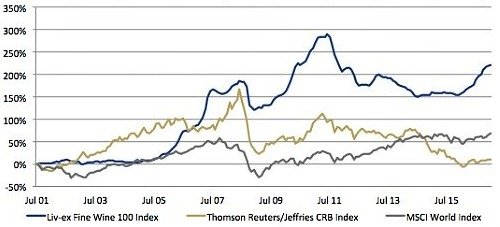Should you invest in wine, or perhaps rather just drink it? For once, Andreas Vetsch, Hedge Fund Analyst at LGT Capital Partners, delves into the world of «liquid investments».
By Andreas Vetsch (pictured below), Hedge Fund Analyst at LGT
 Wine can be a very expensive hobby, at least according to the most recent headlines about Johnny Depp. The actor is reported to have spent $30,000 per month on fine wines – one of the reasons for his financial difficulties.
Wine can be a very expensive hobby, at least according to the most recent headlines about Johnny Depp. The actor is reported to have spent $30,000 per month on fine wines – one of the reasons for his financial difficulties.
In reality, however, wine can be not only a pleasure to consume, but also a very lucrative investment. The rule of thumb here for investors is seemingly straightforward: buy five cases of good wine. After ten years, drink two of them, sell three, and with the proceeds, buy five new cases. But is it really that simple?
Climatic Conditions Limit the Offering
Investments in top-notch wines are not a new concept. In the 18th century, Christie’s auctioned off large quantities of Madeira and Claret at wine auctions. Today, grapes are cultivated on around 0.5 percent of the world’s agricultural land, and there are tens of thousands of wine producers.
Notwithstanding these facts, the selection of investible wines is scarce. According to David Solokin and Alexandra Bruce’s book «Investing in Liquid Assets», only one percent of global production is «investible». While the offering is limited by climactic conditions, demand, on the other hand, knows no limits.
According to the law of supply and demand, these are the perfect prerequisites for rising prices and therefore also profitable investments.
Performance of Fine Wines
On the one hand, past performance shows how lucrative an investment in wine can be. The Liv-Ex 100 Index, the benchmark for the wine asset class, has tracked an annual return of almost eight percent since its launch in July 2001.
And not only the returns are attractive: because of the low correlation to equities and commodities, wine investments are extremely well suited for portfolio diversification. On the other hand, however, the trends in prices also show that although the truth lies in wine, so does risk: investors must be willing to accept potential losses.
An investor who entered the market at the height of the China-driven wine bubble in July 2011, would have lost over 35 percent of the investment within a three-year period. The necessary correction has since been surmounted, and investor confidence is back. Last year, performance was 25 percent.
(Source: Bloomberg)
Special Investments Require Specific Expertise
Those who want to invest in a specific asset class must also have the corresponding knowledge – and expertise is required especially when it comes to wine. This is because the prices of top-tier wines are influenced by three key factors: objective, sensory and macroeconomic factors. Objective factors are characteristics that can be found on the bottle.
For example, a «Haut Brion» 2010 was produced by an outstanding winery and is a top vintage. Sensory factors are determined by wine experts. If the most prominent wine expert, Robert Parker, allocates the maximum number of points to a wine, its price will be pushed up.
Particularly Popular in China
The overall economic environment is also important. Factors such as consumer confidence influence the demand for this luxury good. Further to this, an investor should develop a good understanding of the particularities of the wine market: Lafite Rothschild, for example, is particularly popular in China, which increases its price sensitivity to the economic situation in this country.
In the case of Mouton Rothschild, on the other hand, it is important to know that every year, the wine label is designed by a different artist. There are buyers who purchase Mouton Rothschild for this reason alone, which can drive up the prices of poor vintages.
Bottles or Funds?
Investors who decide to invest in wine have a number of different options to choose from: wine can be acquired «en primeur», or before it is bottled. This method offers the biggest upside potential for returns, but also involves significant risks.
While in the barrel, the product is not yet mature, and there is uncertainty as to its future market price. Wine can also be purchased on the secondary market after bottling. In this case, both the potential for returns and the risks are lower.
Investors also have the option of circumventing a physical investment in wine and instead investing in a wine fund. The advantage: no direct transactions, transportation or storage costs, although such an investment does involve management and performance fees.
Harmonious Finish Guaranteed
The quote: «good wine ruins the wallet, bad wine ruins the stomach», attributed to Friedrich von Logau, might ring true for Johnny Depp – but it definitely no longer applies for investors. Wine investments can be very profitable and can make a valuable contribution to portfolio diversification.
For me, in any case, wine investments are a labor of love with a particular investment characteristic: if the desired rise in price fails to materialize, you can always drink the good bottle of wine yourself.
Andreas Vetsch is a Hedge Fund Analyst at LGT. His area of expertise is trading strategies. Before joining LGT in 2012, he studied at the University of St. Gallen, where he graduated with a Master’s in Banking & Finance and a second degree in Business Journalism. A sports enthusiast, Andreas Vestch enjoys spending his free time biking, hiking or on the slopes. In his blog posts, he examines financial and macroeconomic issues.












